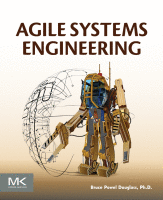Browse content
Table of contents
Actions for selected chapters
- Full text access
- Book chapterAbstract only
Chapter 1 - What Is Model-Based Systems Engineering?
Pages 1-39 - Book chapterAbstract only
Chapter 2 - What Are Agile Methods and Why Should I Care?
Pages 41-84 - Book chapterAbstract only
Chapter 3 - SysML Introduction
Pages 85-145 - Book chapterAbstract only
Chapter 4 - Agile Stakeholder Requirements Engineering
Pages 147-188 - Book chapterAbstract only
Chapter 5 - Agile Systems Requirements Definition and Analysis
Pages 189-279 - Book chapterAbstract only
Chapter 6 - Agile Systems Architectural Analysis and Trade Studies
Pages 281-311 - Book chapterAbstract only
Chapter 7 - Agile Systems Architectural Design
Pages 313-365 - Book chapterAbstract only
Chapter 8 - The Handoff to Downstream Engineering
Pages 367-406 - Book chapterNo access
Appendix A - T-Wrecks Stakeholder Requirements
Pages 407-411 - Book chapterNo access
Appendix B - T-Wrecks System Requirements
Pages 413-417 - Book chapterNo access
Index
Pages 419-429
About the book
Description
Agile Systems Engineering presents a vision of systems engineering where precise specification of requirements, structure, and behavior meet larger concerns as such as safety, security, reliability, and performance in an agile engineering context.
World-renown author and speaker Dr. Bruce Powel Douglass incorporates agile methods and model-based systems engineering (MBSE) to define the properties of entire systems while avoiding errors that can occur when using traditional textual specifications. Dr. Douglass covers the lifecycle of systems development, including requirements, analysis, design, and the handoff to specific engineering disciplines. Throughout, Dr. Douglass couples agile methods with SysML and MBSE to arm system engineers with the conceptual and methodological tools they need to avoid specification defects and improve system quality while simultaneously reducing the effort and cost of systems engineering.
Agile Systems Engineering presents a vision of systems engineering where precise specification of requirements, structure, and behavior meet larger concerns as such as safety, security, reliability, and performance in an agile engineering context.
World-renown author and speaker Dr. Bruce Powel Douglass incorporates agile methods and model-based systems engineering (MBSE) to define the properties of entire systems while avoiding errors that can occur when using traditional textual specifications. Dr. Douglass covers the lifecycle of systems development, including requirements, analysis, design, and the handoff to specific engineering disciplines. Throughout, Dr. Douglass couples agile methods with SysML and MBSE to arm system engineers with the conceptual and methodological tools they need to avoid specification defects and improve system quality while simultaneously reducing the effort and cost of systems engineering.
Key Features
- Identifies how the concepts and techniques of agile methods can be effectively applied in systems engineering context
- Shows how to perform model-based functional analysis and tie these analyses back to system requirements and stakeholder needs, and forward to system architecture and interface definition
- Provides a means by which the quality and correctness of systems engineering data can be assured (before the entire system is built!)
- Explains agile system architectural specification and allocation of functionality to system components
- Details how to transition engineering specification data to downstream engineers with no loss of fidelity
- Includes detailed examples from across industries taken through their stages, including the "Waldo" industrial exoskeleton as a complex system
- Identifies how the concepts and techniques of agile methods can be effectively applied in systems engineering context
- Shows how to perform model-based functional analysis and tie these analyses back to system requirements and stakeholder needs, and forward to system architecture and interface definition
- Provides a means by which the quality and correctness of systems engineering data can be assured (before the entire system is built!)
- Explains agile system architectural specification and allocation of functionality to system components
- Details how to transition engineering specification data to downstream engineers with no loss of fidelity
- Includes detailed examples from across industries taken through their stages, including the "Waldo" industrial exoskeleton as a complex system
Details
ISBN
978-0-12-802120-0
Language
English
Published
2016
Copyright
Copyright © 2016 Elsevier Inc. All rights reserved.
Imprint
Morgan Kaufmann
